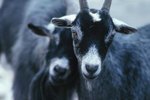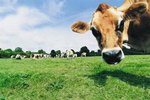In the United States, the Holstein is the most popular milk cow by far. Holsteins make up over 93 percent of cows raised for dairy products, according to the U.S. Department of Agriculture. The next most popular milk cow breed is the Jersey at 5.5 percent. The Brown Swiss and the Guernsey milk cows make up about half a percent each of American dairy cattle. One cow today from these breeds -- after many years of stock breeding -- can produce the same amount of milk it used to take 10 cows to produce.
Holstein
The Holstein milk cow came to North America with Dutch settlers in the 17th century. This breed is popular with dairy farmers, since it yields a high volume of milk on less feed than other dairy cattle. This breed -- with its black and white spotted hide -- is probably the most recognizable, though some Holsteins have brown instead of black splotches. A Holstein calf weighs an average of 90 pounds at birth, with an adult weight of approximately 1,400 pounds.
Jersey
Jersey milk cows originated in Jersey, a small island in the English Channel. This breed is more tolerant of heat than other dairy cattle and adapts well to a variety of climates and terrain. Jersey milk cows are found in North and South America, Japan, New Zealand and South Africa. The Jersey breed is smaller than other dairy breeds, weighing only 900 pounds when mature. However, this breed produces more milk per pound, more than 13 times their own body weight throughout its lactation period, according to research by Oklahoma State University.
Brown Swiss
The Brown Swiss milk cow originated in Switzerland. True to its name, this cow comes in different shades of brown, everything from light tan to dark chocolate. This breed was brought to the United States in 1869 and declared an official dairy cow in 1906. Because the Brown Swiss grazed in the harsh terrain and changeable climate of the Swiss Alps, they were bred to be large and stocky. Gentle and docile, the Brown Swiss has large, furry ears, a banded muzzle and a black tail. The milk of the Brown Swiss is especially good for cheese-making.
Guernsey
When monks arrived on the island of Guernsey off the coast of France in A.D. 960, they brought milk cow breeds from France and Brittany. Centuries of breeding resulted in the Guernsey cow, a small fawn-colored cow that produces high protein, high butterfat dairy products. Because Guernsey milk is also high in beta carotene -- the same organic compound that gives carrots their color -- it is gold-colored instead of cream-colored or white.
References
Photo Credits
-
Jupiterimages/BananaStock/Getty Images
Writer Bio
A freelance writer for more than 30 years, D.M. Gutierrez has had nonfiction, fiction and poetry published in women's, mystery, academic, children's, disability and teen print publications and websites including "Psychological Reports" and "Highlights for Children." She has an advanced degree in psychology from the University of California at Davis.



